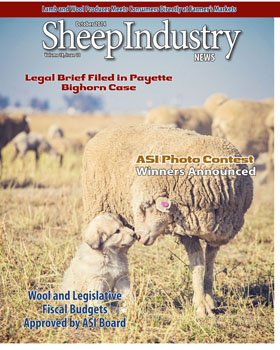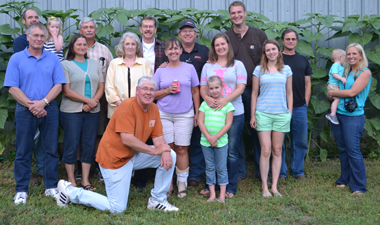
- October 2014
- President’s Notes
- ASI Team Represents Industry in Nanjing
- Belt Buckle Commemorates ASI’s 150th Anniversary
- Colorado Youngster Constructs Lego Camp in Honor of Family Heritage
- Commentary: Recent Headlines Are Example of Public’s Misunderstanding of Protection Dogs
- Dan Wilson: The Best Lamb Marketer is Usually the Person Who Raised the Lamb
- Grazing Allotments, Bighorns Take the Stage at Public Lands Council Meeting
- Market Report
- Nomination Deadline for Annual ASI Awards: Nov. 15
- Opening Brief Focused on Forest Service Payette Errors
- Sheep Budgets for 2014 Approved by Board
- Sheep News in Brief
- Working Together to Make Sheep Better

Working Together to Make Sheep Better
By TERRI QUECK-MATZIE
The size of the average flock of sheep in the U.S. may be one of the reasons genetic progress seems slow, says Dr. Kreg Leymaster, research geneticist at the U.S. Meat Animal Research Center. That’s why cooperative breeding schemes like the Mt. Rushmore Consortium (MRC) make sense.
MRC rotates 16 sire lines through six purebred Polypay flocks totaling around 400 ewes. “You now have six flocks that are genetically linked,” he says, “and the advantage to pooling that data and those resources is a greater rate of genetic progress. Future gains are more predictable in one flock with 16 rams than six flocks with two to three rams each.”
The success of MRC relies not only on cooperation, but on data. All MRC members are enrolled in the National Sheep Improvement Program (NSIP), where progeny and pedigree data comprise Estimated Breeding Values (EBV), a prediction of sheep performance.
“What we’ve done is tie together a group of producers to produce rams and ewes that are useful to the commercial industry,” says MRC member John Anderson (Lambshire Polypay, Shreve, Ohio). “And that’s what it’s all about.”
MRC started in 2009 at the urging of Jerry Sorensen (West Cyclone Farm, Harlan, Iowa) and Larry Bremer (Elm Creek Polypay, Truman, Minnesota). They quickly enlisted Anderson, along with Brandon Grosjean (DB Farms Polypay, Wooster, Ohio) and Chris Kaeb (CAK Polypays, Buckley, Illinois).
Then they went to the big boys. They called Leymaster, fellow U.S. MARC research geneticist Dr. Larry Kuehn, and retired Virginia Tech professor Dr. David Notter for advice. Leymaster says that’s one of the best things they could have done. “It always makes sense to go to the experts. I have a PhD in quantitative genetics, but I know when I’m in over my head and need help.”
Following their guidance, the consortium decided to focus production on the US Maternal Index, which combines data on lambs born, lambs weaned, weaning weight (with an emphasis on birth to weaning growth), and maternal milk. “The focus on the Maternal Index ultimately means more pounds of lamb to market,” says Bremer. “
Leymaster adds an advantage from the beginning was the members’ familiarity with data-based breeding strategies. Grosjean says the data-driven approach and expert guidance adds credibility to the group. “Breeders who aren’t using NSIP data should look into it if they’re interested in improving their respective breed.”
Rams are chosen for their genetic potential in the targeted areas and rotated from flock to flock on a set yearly schedule. Brett Pharo (Pharo Polypay, Rapid City, Michigan), the last to join the group, says the set schedule is important. “I want to know who’s coming each year. Even if it may not always be the best for my flock, I know what I’m going to get.”
The consortium also allows for a ram to be replaced once he has produced a son with better EBVs. But participants soon found that wasn’t as simple as it sounds.
“We’ve now changed that to introducing the son as long as the ewe has never produced a son in circulation,” says Anna Kaeb. “Part of the plan with this is to reduce inbreeding.” Anna says she and her husband Chris are seeing results – in the form of genetic improvement in their flock. “I’ll take a ram from any of these guys any day. We get the best of everybody’s flocks.”
The data also drives the next move.
“Some of our sire lines are nearing the top mark on the Maternal Index, and that’s good,” explains Bremer. “That’s what we’ve been chasing. But now we need to consider if it’s time to change focus and include other attributes that are important to the industry, like wool.”
Sorensen says there are other options going forward. “Maybe it’s time to look within the index to make sheep even better, by focusing on individual traits like milk production.” He says the combined flock boasts well over 200% lambs born and around 200% lambs weaned. “We’re putting more lambs on the ground, so we need to be sure the ewes have plenty of milk to feed them.”
It’s that type of discussion and collaboration that makes MRC successful, according to Leymaster. “The people are the most important factor in any cooperative breeding scheme. They need to have a common mission and be able to compromise.” Organizational structure is important, with clear guidelines as to what it takes a producer to get in or out of the consortium. “They also need to get along. Social time is important as well as business.” In addition to regular emails and phone calls, MRC members gather once a year to share ideas and relax a bit.
But compromising on a common approach still leaves plenty of room for the uniqueness of individual operations. “Mine is pretty typically Midwestern,” says Bremer. “Lambs don’t see grass until after their first lamb.” Pharo’s on the other hand are entirely grass fed and raised with no medical vaccinations.
Biosecurity is an important element of the consortium’s closed flock. Animals are tested OPP and Johnies free, and no flock has had footrot. Pharo says there was cost outlay going in for testing. “But once it’s done, it’s done. It was worth it.” He also had to make adjustments to his beef operation so the species no longer share pasture to control parasites. “Bio-security is something everyone should be concerned about.”
Rather than fostering competition between breeders, the plan allows for more sheep on the market, with breeders often reaching out to fill customer orders.
“Jointly, we have the ability to provide rams for the large customer,” adds Sorensen. “If we have a producer that needs 40 rams, we have them. And we can show him how he can rotate four different sire lines so he doesn’t have to turn around and buy more the next year. And by using our rams across a broad spectrum of flocks, we’re able to prove them in different environments.”

